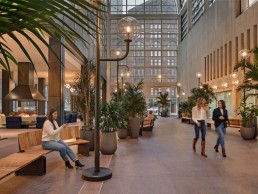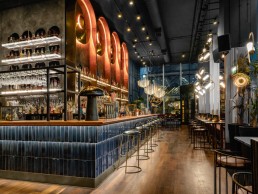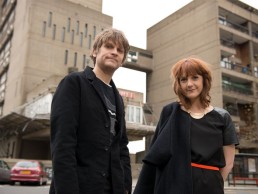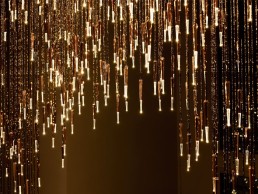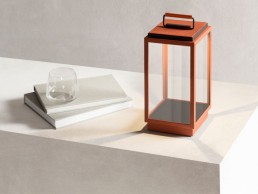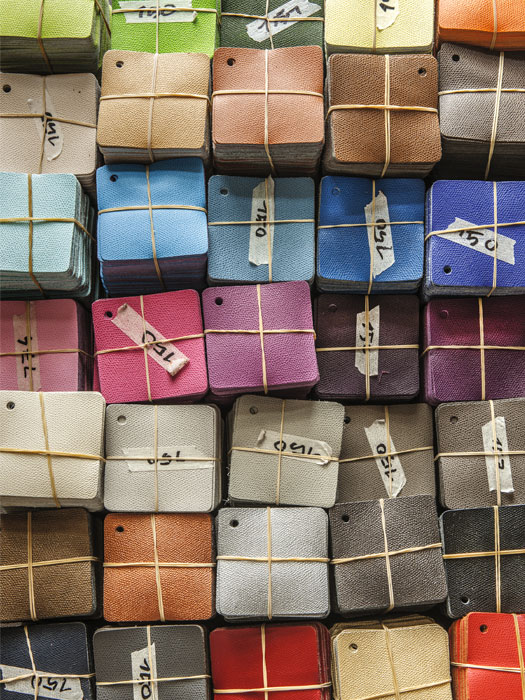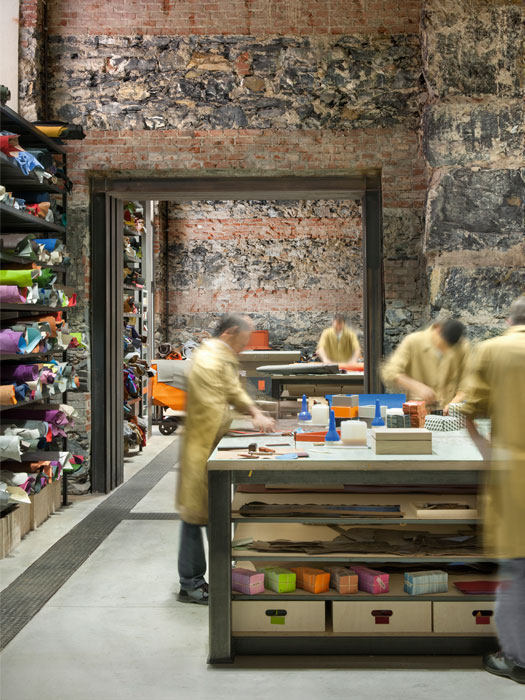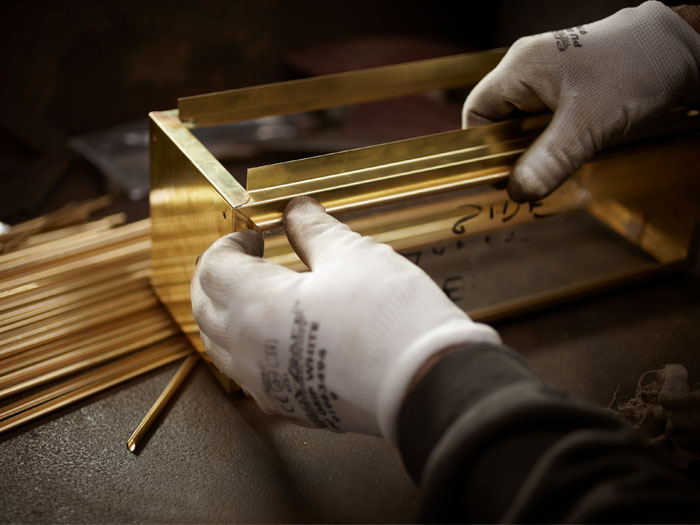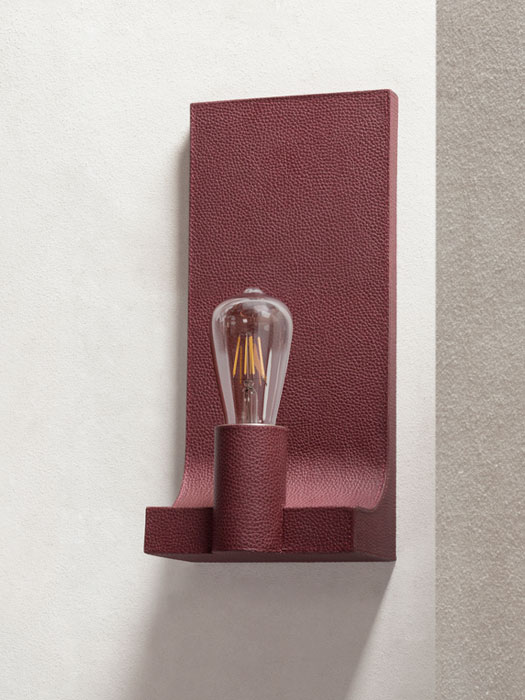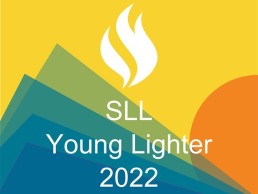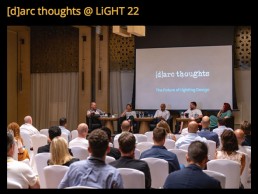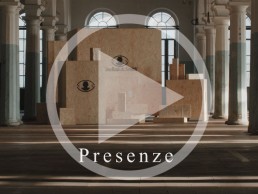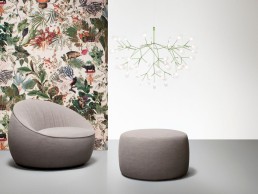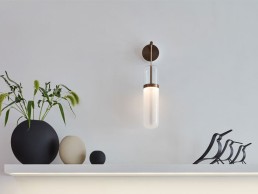1700 Broadway Atrium Campus, USA
Interior design studio MAWD teamed up with Warbach lighting design to produce a stunning exterior-influenced scheme for the Denver-based Atrium Campus. Using lighting was key to making the vast space feel inviting.
Downtown Denver’s first high-rise, 1700 Broadway, was designed by I.M. Pei in 1954. Then, an adjoining Atrium by architect Philip Johnson was added much later in 1983. This iconic building has undergone a contemporary revival by UK and US-based Mawd design studio, with the new space now a nucleus meeting spot for tech firms and leading creatives in Colorado’s capital, providing a flexible and responsive workspace for today’s workers. Beacon Capital Partners, an American real estate investment firm which acquired 1700 Broadway in 2019, appointed Mawd to bring the expansive 27,000sqft glass atrium down to scale, providing a more comfortable, flexible workspace.
Unique to the Atrium’s entryway, visitors can find a front-of-house bike room, complete with lockers, makers tables, and tool storage space. The thoughtfully designed workshop not only supports the city’s biking trends but encourages individuals to enjoy time spent on campus.
Expanding 9000sqft, the communal amenity space features inviting fireplaces perfect for Colorado’s mountainous climate, as well as a wellness space with gym and yoga/sound bath studio, all to enhance the active lifestyles of Denverites. Lighting pieces from Roll & Hill and Artemide add further comforting layers to the communal areas.
darc spoke with Elliot March, Co-Founder of Mawd and Project Lead, to find out more about the firm’s approach to designing various spaces within the iconic building, as well as with Nathan Warner, Principal of the two-person run, US-based lighting design practice Warbach who were appointed to complete both exterior and interior lighting elements.
“Initially, Mawd was brought on to develop and design the project’s amenity space. However, quickly after we presented the initial renderings, Beacon Capital asked if we could become more involved with the project’s overall scope - appointing us as the design lead for I.M. Pei’s lobby. As time went on, we were added to more and more projects, such as the campus’ Bike Room. We are still involved and are now working on F&B adjacent to the Atrium space,” explains March.
Similarly to Mawd, Warbach was approached by Beacon Capital initially for an exterior commission, which later developed into extended interior assignments. “We were approached by the developer and asked to create an extensive exterior light sculpture that would tie the three buildings together, and make them feel like one, unified campus,” says Warner. “After our initial talks with Beacon, they asked if we would expand the scope of our involvement and take on some interior projects as well. That’s how we were first introduced to Mawd.”
March continues: “We drilled into the Mid-Century details that were prevalent, authentic and timeless. We focused on wellness and learning amenities, which we know through research are a major driver for businesses looking to attract and retain the best talent.
“Atrium Campus stands out in terms of sheer scale. The lobby required a large-scale intervention, which provided rare opportunities for innovation in terms of both design and interior architecture.
“Furthermore, while our studio specialises in working within heritage settings, it was a great opportunity to be involved in a Mid-Century project built not by one, but two architectural masters.
"While we work with a number of lighting fabricators worldwide, Warbach was an exceptional fit for the Denver project, not only in terms of regional geography, but in terms of what the Atrium Campus audience would be looking for. Warbach’s focus on craftsmanship was a great match for Denver’s creative and tech workers.”
Lighting, both decorative and architectural, was imperative for achieving the desired atmosphere in the grand, glass-surrounded spaces. As March explains further, the decorative elements aided this concept predominantly: “Compared to the project’s architectural lighting, which was geared towards pure functionality, the decorative lighting helped to fill the space, bringing the lobby and streetscape back down to human scale.
“The street lamps, for example, stand at around 10ft, but provide different levels of lighting just above eye-level.”
Warner adds: “For the street lamps, the size of each lamp post was absolutely massive. There were only two of us installing them, which was difficult to manage due to the sheer weight and scale of the fixtures.
“Throughout the project, scale was our primary consideration. Due to the overwhelming size of the Atrium, we had to get the scale of each lighting fixture right. If the lighting sculptures were too big, they would be overwhelming for visitors. Conversely, if the lighting fixtures were too small, they would be overlooked.
“For Philip Johnson’s glass atrium, we worked to ensure that the street lamps were alternating throughout the walkway to provide the tenant with variation as they moved through the ‘street.’
“For the pendant [custom made by Warbach, situated above the front desk], the scale also remained key, ensuring that the installation height and dimensions were correct. For this pendant, we had to work around the ceiling's existing conditions to properly fix the chandelier. The weight of the pendant meant adding additional support.
“Working within such a large space, we wanted to ensure that the lighting fixtures were able to draw attention, and anchor visitors,” continues Warner.
“We felt that we were successfully able to accomplish this with the chandelier, which helps to show off the magnificence of the building. Although it was a challenge to install, the one large pendant was able to establish a greater presence compared to if we installed several smaller pendants.
“In terms of the street lamps, we feel that the scale of the lamps were able to perfectly mimic the feeling of being outside. In this case, the lamps brought warmth at a familiar height within an expansive atrium.”
March adds, with reference to the pendant: “A cost-effective approach would have been to opt for something along the lines of three smaller pendants. However, we were determined to stay true to our initial design plan. In the end, it was more than worth it. The grand effect of the chandelier creates an initial ‘wow’ moment upon entry. Additionally, the added bonus of the pendant doubling as a wayfinding mechanism is invaluable to the Lobby experience. While we didn’t necessarily need that large of a pendant to light the desk, the scale of the fixture helps to guide visitors as they enter the building.”
As designers that specialise in hospitality and residential environments, Mawd was continually looking to create spaces where “both tenants and employees are naturally encouraged to interact”. “Lighting plays a major part in this interaction,” says March. “Lighting makes spaces warm and welcoming, and in the case of the Atrium Campus street lamps, provide a natural anchor for people to sit down and congregate around.
“Compared to most architects and designers who work within a lighting range of 3000K, our team continually pushes for 2700K, which is closer to the incandescent lighting in your home. Working within this spectrum that we use frequently in our speciality fields of design, we are able to create an atmosphere that is welcoming, comfortable, and familiar. [Warbach’s team also ensured Edison light sources were used throughout to maintain consistency].
“While there was ample lighting in the tower to start, we saw decorative lighting as the jewellery of the space, as an opportunity to add warmth, and to create an inviting atmosphere,” continues March.
The street lamps within the glass atrium help reinforce directionality, guiding guests and visitors through the streetscape towards the Spanish Steps.
“Lastly, decorative lighting successfully helped to define each individual area, such as keeping the look and feel of the lobby distinct from the look and feel of the atrium’s streetscape. The light not only defines the space, but brings ambiance and atmosphere, which supports interaction.”
Throughout the process, Mawd’s approach evolved in two primary ways. March expands further: “Firstly, as the brief evolved to incorporate the lobby, it became an exercise in modern workplace design and architectural intervention. Not only was the lobby designed as a public space, but the area’s scale allowed us to transform the welcome experience and the ground floor’s directional flow. This was primarily achieved through the addition of Spanish Steps and transformation of the streetscape.
“Secondly, the addition of Philip Johnson’s glass atrium and the lobby space help to shift the design focus to preservation. The historic significance of both Johnson and Pei’s work impacted our design process in the sense that we prioritised keeping the Mid-Century design details alive throughout the renovation. One such example includes the lobby’s flooring, which we maintained, in addition to adding in furniture and fixtures inspired by this period.
“One challenge we encountered during the design build-out involved the placement of the street lamps throughout Philip Johnson’s streetscape. Fabricated by Warbach, we designed these in the spirit of Johnson’s original fixtures. In order to add the new street lamps within the Atrium, we had to dig into the ground to extend power to the fixtures.
“In the end, the unexpected digging was well worth it. We were able to add convenience power to the base of each lamp - a contemporary upgrade that allows the building’s tenants and guests to sit, relax, and recharge their laptops or tablets.”
March also notes that the use of strong digital renderings at the beginning of a project can aid in the process going as smoothly as possible. “Our studio prides itself on our photo-realistic renderings, which remain an integral part of our process. Our team’s ability to deliver designs that stay true to our initial briefs is something our clients appreciate.
“This also holds true for the lighting designers we work with. Getting the renderings right for Warbach, for example, provided their team with a strong visual to work off.”
Overall, the project has been a great experience and success for all parties involved. Warner reflects on the pride he felt upon completing the project in a favoured city of his: “We specialise in large-scale projects, so this was well within our area of expertise. However, working on the Atrium Campus project was notable as I have admired the work of I.M. Pei for decades, and I have created many past works that were inspired by his architecture. It was an honour for my work to be installed within his building. Also, I have always loved Denver, and have wanted to create work for this city.
“We’re craftsmen, and between me and my business partner, we fabricate and finish everything. There is a lot of love that goes into these projects. We are happy with how the project turned out, and the fact the entire project went smoothly, especially in terms of fabrication. We felt that the scale was spot on, and that all of the fixtures were oriented in the correct direction.
“In terms of working with the initial plan, renderings are so good these days, you know exactly what the final result is going to look like.
“Denver is a working city, and we thought that its residents would appreciate something that was made with our working hands.”
March reflects on the relationship between Mawd and Warbach and the value he gives to lighting fabricators on projects in general: “Our experience working with Warbach was exceptional. We regularly work with lighting fabricators due to the technical aspect of lighting, and the designer’s vast knowledge of millwork and LED technology.
“Both our team and the client have been thrilled by the project, and we look forward to continuing to work with Beacon. We appreciate our client’s faith in us, and support for the design details we believed to be important.”
The Alchemist, UK
The Alchemist is a well-established cocktail and restaurant chain with 20 venues across the UK. DesignLSM was responsible for creating the new interiors for The Alchemist’s Spinningfields location in Manchester.
Speaking with Karen Taylor, Design Director at DesignLSM, darc finds out more about their design intentions and stunning decorative lighting pieces selected for The Alchemist's moody and atmospheric destination in the north of the UK.
Thanks to the design firm’s extensive experience in hospitality design, The Alchemist team approached DesignLSM to transform and refresh their site located in the heart of Manchester’s Spinningfields.
“The brief included achieving greater operational efficiencies and updating the aesthetic to create an engaging and dynamic guest experience that transitioned through the day and better blended the bar and dining spaces,” says Taylor. “From concept to completion, the project was a very quick turnaround; we were only on site for one month!
“Usually we work with lighting designers, but for this project we successfully managed this in-house, working in collaboration with the manufacturer. We worked around the existing architectural lights within the venue, carefully curating a strong variety of additional feature lights to create the ambience and visual interest that we envisioned for the space. We worked closely with an electrical consultant, Nebro, to ensure we were using the right lamps to create a warm and glowing atmosphere.”
DesignLSM’s brief took the Manchester location in a new direction for the brand. “It was important to understand the DNA of The Alchemist and what their future aspirations were from a strategic perspective before establishing the design narrative,” explains Taylor.
“The site needed to work from day to night, but with extensive floor-to-ceiling glazing around half of the venue, it was a challenge when it came to ensuring an organic ambience was created throughout the day.
“The typical challenge with refurbs is that you’re having to work with some existing elements whilst delivering a new look and feel for the space. In this venue, it had extremely high ceilings so it was essential to create big-scale drama otherwise the design would get lost. We selected decorative and immersive features and lighting that could hold the space, whilst embracing the layering of beautiful lighting (suspended lights, wall lights and integrated lighting) to create an intimate ambience in the evening.
“It was important for us to play with the drama of the narrative, reflecting the brand’s theatrical offering. It was key for us that the space felt immersive and reflected the playful DNA of the brand,” she continues.
“Addressing the operational objectives of the brief, a lucid identity was well-thought-out for the two main spaces – the bar and main dining area, as well as designing an additional intimate PDR (private dining room), improving the fluidity of movement between the whole venue whilst also creating engaging zones.”
Understanding The Alchemist’s commercial, operational and experiential objectives ensured the team stayed on brief consistently throughout the project. These elements helped to “define a clear and thorough foundation for our team to work from”.
“The Alchemist pride themselves on creating theatrical experiences, showcasing their creativity and innovation through mixology.
With the brand’s strong reputation for its unique offering across the country, it provided DesignLSM with an excellent opportunity to push the boundaries on curating a compelling and unique concept that would reflect the evolution of the brand’s DNA and transitioning narrative, drawing inspiration from the origins of the universe and cosmic alchemy.
“Strategically considering the overall guest experience, curating hero features that would define the space, the back bar – playing upon astronomical dynamism - has now become a striking focal point, accentuating the relationship between light and dark with beautifully framed circular lights that emit a soft glow during the day that enhances and becomes richer in hue and bolder in strength as the evening progresses – marking the solar/lunar progression.”
As mentioned, the space the team were working with featured very high ceilings, and lighting played a key role in managing these comfortably.
“Lighting was one of the main elements of this project and nearly all features were bespoke except two wall lights,” explains Taylor. “All of the lighting formed part of the compelling concept - every piece was carefully chosen to enhance the cosmic alchemy narrative and represent orbital pathways of planets and supernovas.
“Specifically though, is the large bar feature, which dominates the space and reflects the transition from day to night. The large glowing orbs that transition from warm white to amber to red represent the sun and its dominating/illuminating presence – as the day progresses, these orbs softly start to glow until darkness falls when they burn bright creating a striking and dominant golden glow.
“We used several manufacturers to produce our different light features, which were all carefully selected or designed to enhance the cosmic concept. With 80% of the lighting bespoke, we worked with Illumination to manufacture all the custom features including the main restaurant lights, comprising of approximately 125 led suspended Perspex rods, which were created to represent the swirling gasses in space, the suspended lights in and the PDR emulating planets.
“The glass wall lights (sourced from Chelsom) were strategically positioned on the columns representing the sun and the moon, whilst the mesh lights from Moooi created dramatic sculptural statements at the entrance of the venue.”
Lighting was an important element in the curation and designation of different zones throughout the space. The pieces aided in creating intimate spaces whilst in the main restaurant and bar, it was important to the team to deliver dramatic focal points to fill and illuminate the open areas. The sculptural aspects also enhance the changing ambience of the day as it transitions to night.
“For the private dining room, we created The Alchemist’s version of space, with seven planet-inspired lights, helping to create a welcoming area for groups,” continues Taylor. “In the bar, we opted for planet pendants, visible from the exterior façade.
“The female toilets, a dichotomy from the dark moody tones of the front of house, take a confident contrasting approach with wall lights that radiate energy along with the lively orange colour palette creating a burst of vibrancy whilst complimenting the terrazzo walls – a representation of fragments floating in space as a result of an exploding supernova.”
Using the already existing architectural lighting, the team were fortunate that the system was already very flexible, allowing them to reposition and re-angle fixtures to complement the additional feature lighting.
“Due to the open and exposed surfaces to the ceilings, we utilised cable trays, which were sprayed out across the ceiling in the same dark tone, accentuating the glow of the suspended lights whilst enhancing the cosmic narrative that each lighting feature played into. The main challenge was working with the existing surfaces, so feature lighting had to work around this.
“The lighting completely elevates the whole space, creating theatrical focal points throughout,” says Taylor on how the lighting accompanied the interior design scheme as a whole. “As soon as you step inside, you get a real sense of the narrative behind the design and the brand. Being an all-day drinking and dining destination, the lighting allows the space to subtly transition from a lunchtime spot to a vibrant drinking destination in the evening.”
The overall impression and reception from The Alchemist team has been resoundingly positive. “From the get-go, the concept was well interpreted and we’re extremely proud of the space we have created, and the new direction we have delivered for The Alchemist,” explains Taylor. “Since re-opening, we’re thrilled with the positive feedback we have received from both the client and the public. Despite there being a vast selection of drinking and dining destinations in the city, The Alchemist sets itself apart from other bars and restaurants in the local vicinity and remains one of Manchester’s most renowned social hot spots.
“We’re extremely proud of what we have created, with the finished space being a strong replication of our visuals. As with all projects, we are continuing to identify innovative ways to incorporate digital integrations, layering the physical space with technical elements to further enhance the guest experience.”
Douglas Road - Run For The Hills
Design duo Anna Burles and Chris Trotman, Founders of design practice Run For the Hills, renovated their London home on Douglas Road during 2020/21. darc asked Burles to provide commentary on their decisions and influences behind the lighting pieces used throughout their home.
During the height of the UK's national lockdown, Co-Founders of London-based design house Run For The Hills, Anna Burles and husband Chris Trotman decided to renovate their private home.
The couple's recently renovated, dated Victorian house in West London, was previously set up as two unmodernised flats. It needed to be formally de-converted back into a family home before planning could be granted for a side return and a three-room loft conversion.
The finished house is now a five-bedroom, three-bathroom property, with a stunning design bearing all the hallmarks of the creative duo’s personal style, flair and imagination.
Works began in August 2020 and finished in February 2021, a design-build collaboration with long-time construction partners JNJ Building Services. The team gutted the ground floor completely and reconfigured the layout, removing the double front living/dining room that many people opt for, instead keeping a small adult living room at the front, a small utility/guest bathroom, and then a large open-plan family space at the rear onto the garden, rebuilding all the brickwork to the old part of the house with full width crittal doors in a dark bronze metal.
In keeping with the studio’s design aesthetic for clients, their own home is very creative, cosy, and comfortable for their family-orientated life.
“As we’re designers, we knew we could push things and be innovative and daring, so we let our imagination run riot," says Burles. "The concept is very personal to us and we spent all of our waking hours and weekends, outside of running the studio, to develop the design and to specify everything needed.”
The house has a stylishly modern feel, with crittal doors throughout the ground floor bringing refined urban styling. The design also boasts dramatic, oversized decorative covings, flower petal ceiling roses, and a vintage-feel but with new herringbone floors, all of which keep the house feeling warm, inviting and full of period character.
Lighting is always an integral part of any design, and as such, darc asked Burles to walk us through the lighting choices throughout her new home.
"Lighting is such a huge part of any interior design and we wanted our home to be lit beautifully. Great lighting needs to be designed carefully into the scheme from day one and it’s utterly transformative and can elevate great design details to be real show-stoppers. As such, we wanted to ensure full control over the lighting in the property to allow for spaces to operate as cosy and relaxing or more task-focused depending on the needs. So, after doing the first cut of the lighting design ourselves, we enlisted the help of a lighting designer and a mood control company to add a smart lighting system to the property, using key pads with tailored settings input to suit the family’s needs with a flick of a switch, allowing maximum control over the light settings in the house.
Lighting Designer Collaboration - GKLD
We had big plans for the lighting in the house to be great – something we’ve learned from our commercial bar and restaurant design work – a great design can be transformed into an amazing, jaw-dropping design with great lighting, so we knew we’d need help specifying the right kind of architectural lights, beam angles, colour temperatures, and optics (which is such a specialist skill). We also had plans to install a mood lighting system in the property, to transform the atmosphere of a room from bright to moody and candle-lit dinner party at the flick of a switch, so we decided we needed to enlist the help of professional lighting designer Guy Kornetzki of GKLD.
Lighting Design Process
Kornetzki sprang off from our initial lighting concepts and decorative CAD lighting and electrical plans (with our initial suggestions of what lights could go where and how we’d like them to be controlled – with all decorative lamps and floor lamps coming on at the same time for example, or a pendant or chandelier being controlled separately). Kornetzki would import our CAD plans and then bounce back ideas to us, confirming the ones he thought we’d got right, and making alternate suggestions. Once we had a range of ideas we all loved, he then calculated and estimated the fittings we’d need, the quantities, where they’d be sited, and how the light would project and highlight what we wanted it to showcase. We’d then run that all by JNJ’s lead electrician, Ben Jenkins, to sense check it from a wiring and load perspective. It’s a technical process and great to have someone who can act as the bridge with the electrical contractor, who can talk knowledgeably about hidden drivers, connectors, and widgets, which make systems and circuits talk to each other.
Choosing Light Sources
I then researched and found the best lamps to use in the decorative lights, wall lights, floor lamps, and table lamps, all of which needed to be intelligent LED dimmers to work well on the lighting system, running my findings by Kornetzki to check. Researching the wattages needed per fitting and finding nice products, which would harmonise an overall colour temperature and mood that was warm not cold. I ended up selecting a mix of G9s and lovely filament and porcelain-style lamps from Tala in warm whites and super warm whites to create a really cosy effect. For the LED strip lighting under the shelves in the kitchen, Kornetzki specified an IP65 rated strip in a warm white 2200k for a comfortable look. All of the architectural downlights were specified by Kornetzki and came from Orluna. They create a really lovely light, in warm white in a variety of beam angles depending on what we want to illuminate. Lights specifically illuminating art were a bit cooler, to keep colours true, but still warm white. Lamps illuminating finishes and upholstery were kept soft and warm.
Mood Lighting System
Kornetzki also helped us research and find our mood lighting controls partner, helping refine the brief, scope and costing, and continued as liaison with them through the life of the project, helping us understand the technical side of the system and how we could get it to work the way we wanted. You wouldn’t believe how much wiring is in the house to control the system, it was like spaghetti junction. It’s expensive, and much more than just having dimmer switches everywhere, but it takes the lighting to a completely different level. We’re so pleased to be able to control the lighting in a really sophisticated, super speedy way.
Some of these mood systems allow you to control the lighting from your phone, and to change the settings of each light source within a scene.
The lighting design was a really close-knit collaboration between us as the main designers, the Electrical Contractor Jenkins from JNJ, Lighting Designer Kornetzki, and the mood controls system team.
Mood Control 'Scenes'
When designing the ‘scenes’ on the control panel it’s essential to do it at different times of the day, including late into the evening, to make sure you’re getting it right. In most zones we opted for five control settings including: Bright, Dimmed, Moody, Dinner Party Candlelight, Reading Lights-only and Off. Some keypads have double click functionality, switching control to another room, setting it at the same scene you’re using (useful in an open-plan room where you want to set the whole room to cosy, without having to walk over to all of the keypads). Other keypads have press and hold to set a timer for lights to turn off after 10 seconds or so, allowing you to get up the first flight of stairs before they turn off. The ‘All Off’ button by the front door is great for turning off every single light in the house before you leave.
An Artful Design – the art story
One of the big signatures in the house design is the art, which fills so many of the walls and is picked out beautifully by the lighting design. Many of the art prints are by Chris (aka artist Dex) and myself. All of the art was planned and fittings chosen to wash certain sized pieces displayed on walls, fireplace mantels, and on shelves.
Display Cases
Art is also homed in a large, glazed display case-come-curiosity cabinet in the kitchen/diner family room, which was originally designed as a wardrobe, but which we turned into a museum-style display cabinet filled with props, accessories, curios and art. This cabinet also has integrated lighting to make the contents glow as if in an art gallery or museum.
Mission Control
The lighting controls are discreetly hidden on both the ground floor and first floor in pieces of joinery. For the main ground floor hub, we designed a really complex but great understairs set of storage pieces, some of which are fixed and some pull out on wheels to give access to the sizeable Helvar lighting control system and fuse boards behind. The drawers unit has a mix of sizes, including a deep one for kids' helmets and school bags and then lots of little drawers with labels for small tools, batteries, bike lights, first aid, and sunglasses – literally a place for everything. Then some post racks above for notices from the kids' school, umbrellas, and other small items that would usually be stashed in a drawer of doom.
House Images: Philip Durrant
Dusk - ByBeau
ByBeau's newest bespoke creation Dusk has been a work in progress as the team waited for technology to catch up to fulfil the aesthetic desires. The stunning installation transforms any space from dawn to dusk.
Dusk, created by studio ByBeau, is inspired by the time of day when shadows grow and light becomes copper-gold; dusk.
Each copper body of Dusks’ stalactites forms the base to apply precious metals like gold, silver or a myriad of non-precious finishes. This flexibility allows full customisation to create a "personalised sunset".
Beau McClellan, Creative Director, says: "The ideology behind Dusk was a form that would work equally well within both classical and contemporary environments. Dusk soon became an exploration in temporality; waiting for technology to catch up with a design intended to prevent time from doing the same to its aesthetic."
Hand-ground crystal tips are seamlessly attached to each copper finger, with each angle precisely aligned. Great care was taken to ensure that no trace of manufacturing threatened the organic feel of Dusk.
The angles refract and reflect light throughout the chandelier, bouncing it from element to element. "This produces a sensory experience reactive to the configuration and scale of the whole piece. Flickering and glistening; alive with the arcs and patterns created," adds McClellan.
Each finger houses a powerful LED - of specific colour temperature - that is small enough to fit comfortably within. "The breakthrough unit used in Dusk combines extraordinary power with compact size. A challenge to the clean lines of the design was posed by the more powerful LED requiring the incorporation of a far more effective heat sink to dissipate the temperature.
-
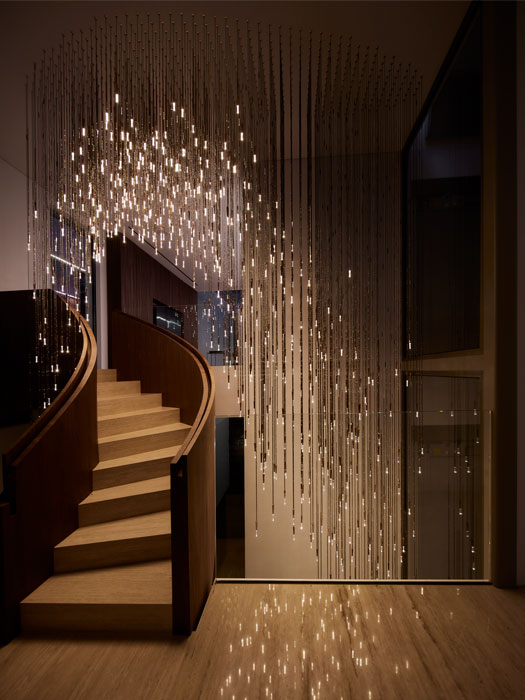
All images: Vasco Celio/stills
-
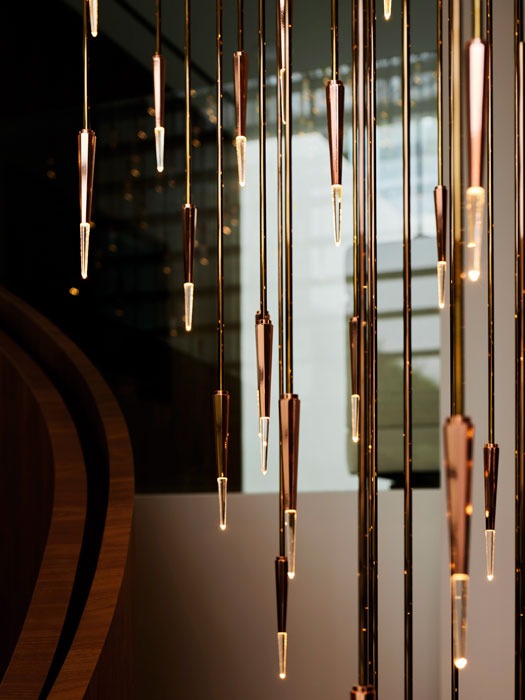
"Dusk aptly transitions between day and night without imposing the ambience of either. Twilight has an illusionary nature with the sun neither above the horizon nor below it; a balance of day and night - there cannot be one without the other, yet they cannot exist at the same time. Our Dusk represents dualism; a bond of form and function, of classical and contemporary…of night and day.
"Dusk is a piece that showcases many of the philosophies that define the work of ByBeau. The time it took to produce is a testament to our team’s dedication to their art. As artists we seek to challenge ourselves; to produce the creative, rather than the easy," McClellan concludes.
Tekna x GioBagnara
Working together with Italian leather brand GioBagnara, Tekna has produced a new collection consisting of existing fixtures but finished in sleek leather, available in numerous colours.
Tekna’s recently released collection was formed in collaboration with Italian leather brand GioBagnara. Bringing together leather and lighting is a new approach for the Belgium-based brand and one that brings a less-common material to the lighting specification market. The new collection is comprised of the Blakes table lamp, Marquesse floor lamp, and Walcott and Walcott Twin wall lamps.
“The Tekna x GioBagnara collection aims to create pieces able to generate unique atmospheres and enhance spaces, giving birth to a union where traditional Italian and Belgian lifestyles meet,” says Tekna. “[We] have loved unique and durable materials including brass and bronze since day one. Leather is a great addition to this, as it is unique and in this way distinguishable.
“We have chosen to work with leather because, in addition to the qualitative aspect, it also gives an extra structure to the finish. Leather can do a lot with your interior. It all depends on the way you use it as to what kind of leather you use and with which colours you combine.
“Leather lends itself very well to the upholstery of our appliances as they contain a lot of details including ledges and glasswork. All these details need to be finished to a high standard, which we thought other materials, such as wood, would not allow.”
The collaboration between Tekna and GioBagnara was born from Tekna’s long-standing admiration for the leather brand and its craftsmanship. Since approaching GioBagnara a few years ago, the teams worked together to produce this new collection after numerous design meetings and product prototypes within four months.
“The concept is simple but works tremendously. We cover existing lighting fixtures with leather, which creates a totally new approach to lighting. By working with leather the light produces a very different glow,” continues Tekna.
“For this collection, we chose to transform some of our bestsellers into works of art in leather. And this combination resulted in great success. This is found in the details, and the fine craftsmanship, the hand-applied leather and stitching details, which in all have created an enhanced decorative element of this collection.”
One of the challenges the teams found throughout the process of working with a new material was ensuring that the aesthetics and functionality were not compromised. The hand-crafted approach meant they could keep an eye on the details and finishes, and make tweaks along the way that supported each individual fixture.
Wanting to maximise the customisable features of these lamps, it is possible to choose from more than 370 leather finishes and more than 100 colour swatches and stitch colours. This enables the user to select a unique combination for their product to suit their residential or hospitality space. “This way you can choose the eye-catcher for your home or opt for a more simple and ton sur ton piece,” says Tekna.
“We want Tekna to be the Louis Vuitton of the lighting world. And just like buying your favourite handbag, we want to emulate that special feeling. This collection complements it perfectly,” it concludes.
Entries open for SLL Young Lighter 2022
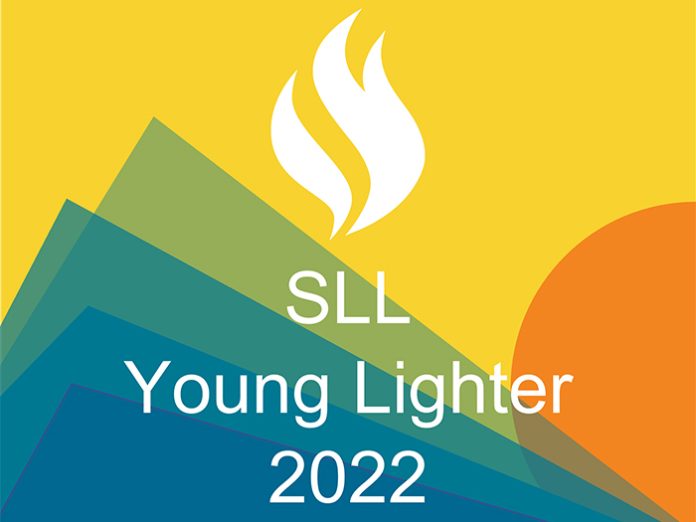
(UK) – The Society of Light and Lighting (SLL) has announced that entries for the SLL Young Lighter 2022 are now open. Aimed at people in the early stages of their lighting career, the competition is open to anyone under the age of 30 with an interest in light and lighting.
Entries can be based on any light-related topic, and the winner will receive £1,000 in prize money, along with the prestigious title of SLL Young Lighter 2022.
The competition is designed to provide people with a platform to share their lighting ideas – this could be a piece of research, a lighting concept or design, new technology or product, or even a proposal for a new lighting metric or design methodology.
Previous winners include Maria Englezou, whose winning paper questioned current approaches to the design of lighting for healthcare facilities rooms; Aluwaine Manyonga, who proposed an off-grid solar lighting system to help provide improved access to education in Africa; and Anna Wawrzyniak, who proposed a light boosting system to support the circadian rhythms of commuters using underground transportation for their commute to and from work.
The competition is open to entrants from all over the world and is broken into three stages. Entry Stage One calls for six introductory Powerpoint slides outlining the entry. These could include images, illustrations, graphics, animations, text, voice etc; at Stage Two, the SLL will ask entrants to elaborate with a short presentation to expand on their initial ideas. This can be in whichever format they feel illustrates the entry best; for Stage Three, finalists will be selected and invited to deliver a 15-minute presentation in front of an online audience.
Entries are open until 25 August. More information can be found on the SLL website here. Or you can email sll@cibse.org for further details.
LiGHT 22 announces talks programme

(UK) - Alongside LiGHT 22's exhibition, the team at [d]arc media bring you its latest instalment of [d]arc thoughts.
In collaboration with Lutron, the two-day talks programme will feature insightful comments and discussions from designers working at some of the leading studios in the industry.
Confirmed topics include:
DAY ONE
- The Future of Materials
- Lighting Design as a Strategy for Inclusion
- Starting out in Design
- The Lifespan of a Project
DAY TWO
- Design for Wellness
- Specifying Bespoke Lighting
- The Weaponisation of Light
- Dark Skies
More topics and speakers are to be announced soon.
Catellani & Smith's 2022 collection
In 2004, colour was introduced into Catellani & Smith’s catalogue for the first time with its PostKrisi collection. It used colour as a message of rebirth and joy. Today, that colour returns in its 2022 collection, presented here in a film by Giorgio Oppici captured earlier this year.
Moooi - Heracleum
Moooi’s iconic Heracleum is now available in a brand-new colour: Green.
The Heracleum is a Moooi Original design with a strong presence in the collection since its first introduction in 2010. The lifestyle brand honours its Moooi Originals by further improving them with new technology added into Heracleum III and a new colourway. The updated design in a new colour highlights its floral inspiration.
Also, all designs in the Heracleum III family are now compatible with Moooi’s Wireless Wall Switch.
Skills Army launch photography competition
(Online) – Skills Army has launched a photography competition, inviting participants to tell a story through shadows.
The competition, open to all through LinkedIn, asks entrants to “give a shadow a new dimension”, and to celebrate the power of shadows.
To enter, participants just need to post their images to LinkedIn, tagging Skills Army and using the hashtags #shadowart and #skillsarmy.
The winning entry will win an iGuzzini Pizza Kobra light fitting, designed by Ron Arad.
Michael Grubb Studio promotes Daniela Rendon to Project Lighting Designer
(UK) – As part of its ongoing response to significant levels of rapid growth, Michael Grubb Studio has promoted Daniela Rendon to Project Lighting Designer.
Having worked for the studio since 2019, Rendon has demonstrated her commitment to the lighting design industry. Her skills and knowledge have undoubtedly contributed to the success of many of the company’s recent projects.
In her new role, Rendon will manage design projects at varying stages of completion, working with a senior team member to ensure deadlines are met. She will put her self-motivation, good initiative, and organisational skills to good use, as well as demonstrate her ability to liaise with suppliers, clients, and design teams.
Rendon will be able to draw on her vast experience of working on projects of varying scales, across multiple sectors. These include the award-winning Bath Abbey project, King’s Walk Shopping Centre in Gloucester, and Woolsery in Devon. She has also been an active participant in industry events such as the creation of a lighting installation at the [d]arc Awards 2019, as well as being crowned a Technical Award Winner at the 2021 SLL Ready Steady Light challenge.
Speaking of her new role, Rendon said: “I am very excited to start my new position. I truly appreciate the opportunity and look forward to continuing to grow, as well as contributing to the creative and talented team of Michael Grubb Studio. I feel extremely motivated and encouraged by the team support, which makes coming to work an absolute joy.”
Michael Grubb, Founder and Managing Director of Michael Grubb Studios, added: “Daniela has proven herself to be a committed team member, with excellent lighting design and project management skills. In her new role, she will be able to build on these, as well as taking a more prominent position with clients and other stakeholders.
“I’m extremely proud of Daniela and it has been wonderful to watch her grow and develop as part of the Michael Grubb Studio team.”
Empty State - Pill Wall Light
Complementing its portfolio of statement pendant lights, the Pill wall light is Empty State’s first foray into wall-mounted lights. An adaptation of the existing capsule-shaped design, the light offers a new perspective, whilst remaining beautifully designed with exquisite attention to detail.
Combining handblown coloured glass with sharp brass accents, Pill delivers modern elegance and luxury. With a modular design comprised of customisable glass colour, metal finishes and light configurations, each piece is made to order, exquisitely designed and made by hand in London.
With its striking design and compact size, Pill provides an eye-catching lighting solution, suitable for a variety of spaces throughout the home. Hanging from its elegant, circular mount, the light reflects a soft, illuminating glow off the wall, creating an inviting and intimate space. From adding a contemporary feel to a bathroom to lighting a dramatic staircase, the Pill wall light can be used in both traditional and modern decor whilst adding artistic flair to any space.
Available in five stunning finishes including black anodised, silver anodised, brushed brass, burnished brass and polished brass, Pill can be paired with a variety of coloured glass options ranging from a bold, bright blue and opal to smoked, green and soft, pale pink.
Providing well-appointed lighting solutions to design-orientated homes and interiors, Empty State draws inspiration from contemporary architectural styles and design icons through the ages, with each product made with ultimate precision to the finest detail.

